| Siege of Hostalric | |||||
|---|---|---|---|---|---|
| Part of Catalan Civil War | |||||
| |||||
| Belligerents | |||||
| | | ||||
| Commanders and leaders | |||||
| | | ||||
| Strength | |||||
| 300 | 500 | ||||
The siege of Hostalric was the first major action of the War Against John II. It took place on 23 May 1462.
| Siege of Hostalric | |||||
|---|---|---|---|---|---|
| Part of Catalan Civil War | |||||
| |||||
| Belligerents | |||||
| | | ||||
| Commanders and leaders | |||||
| | | ||||
| Strength | |||||
| 300 | 500 | ||||
The siege of Hostalric was the first major action of the War Against John II. It took place on 23 May 1462.
In 1460, after John II imprisoned Charles of Viana, the Catalans at the Corts de Lleida formed the Council of the Principality (Consell del Principat) in opposition to the government of John in the Principality of Catalonia. The Consell demanded that John liberate Charles immediately and accept the Capitulation of Vilafranca, which prohibited John from entering Catalonia without the permission of the Generalitat so long as he disagreed with their legislation. [1] John capitulated.
The subsequent death of Charles only three weeks after his liberation threatened the peace. The king sent his wife, Joana Enríquez, to Barcelona with the intention of overturning the capitulation and sowing discord among the Catalan factions. [1] [2] The relationship between the queen and the representatives of the Catalan government was strained during the six months she was in Barcelona with her son, Charles' successor as heir, Ferdinand. In March 1462 the queen and the prince left for Girona, while the pagesos de remença revolted against the government in hopes of receiving royal support and abolishing the mals usos .
At Girona the queen convoked a general council on 23 April 1462. She reorganised the citizen militia and proceeded to repair the city's walls and towers. [3] On 12 May she sent a force of 200 men to Bernat Joan de Cabrera, head of the garrison of Hostalric. On 13 May the Consell del Principat sent an ambassador to the castle to assure that the council's army, which was marching on Girona, would be well received.
In a final preparation for battle, Joana sealed an alliance with the leader of the remences, Francesc de Verntallat. The rebels agreed to bar the pass of the Consell's army at Hostalric, while Joana sent 600 men to reinforce the remences. A ship of arms and food was sent to Sant Feliu de Guíxols to gain time as the remences organised themselves. [3]
The army of the Consell was commanded by captain Pere de Bell-lloc i de Sentmenat. [4] After easily frightening the remences of Verntallat into retreat on 23 May, Pere besieged Hostalric. [5] The remences fled to Girona.
To impress upon the town the urgency of surrender, Pere began destroying the surrounding vineyards and wheat fields. The townspeople opened the gates to the Consell and the town fell without a fight. The castle too was surrendered without combat, but the Tower of Friars, defended by a single man, was attacked by the crossbowmen. Bernat Joan de Cabrera was taken prisoner. On 29 May the Consell sent the remainder of their army stationed at Barcelona to besiege Girona. Hostalric remained a stronghold of the Consell until the end of the war.

The recorded history of the lands of what today is known as Catalonia begins with the development of the Iberian peoples while several Greek colonies were established on the coast before the Roman conquest. It was the first area of Hispania conquered by the Romans. It then came under Visigothic rule after the collapse of the western part of the Roman Empire. In 718, the area was occupied by the Umayyad Caliphate and became a part of Muslim ruled al-Andalus. The Frankish Empire conquered northern half of the area from the Muslims, ending with the conquest of Barcelona in 801, as part of the creation of a larger buffer zone of Christian counties against Islamic rule historiographically known as the Marca Hispanica. In the 10th century the County of Barcelona became progressively independent from Frankish rule.
Ayxun or Aissó was a nobleman who led a revolt in Barcelona, Ausona, and Girona in 826 to 827. His identity is uncertain.
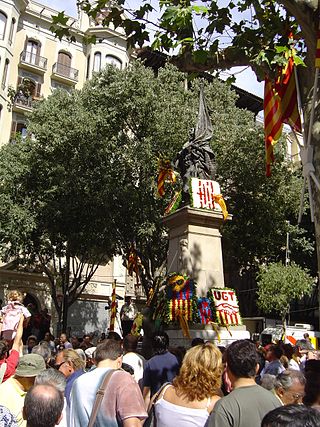
The National Day of Catalonia, also known as the Diada, is a day-long festival in Catalonia and one of its official national symbols, celebrated annually on 11 September. It is one of the public holidays in Catalonia.
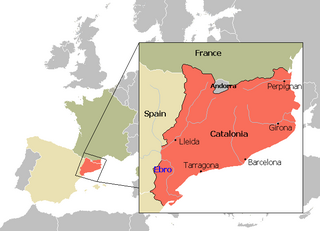
The Principality of Catalonia was a medieval and early modern state in the northeastern Iberian Peninsula. During most of its history it was in dynastic union with the Kingdom of Aragon, constituting together the Crown of Aragon. Between the 13th and the 18th centuries, it was bordered by the Kingdom of Aragon to the west, the Kingdom of Valencia to the south, the Kingdom of France and the feudal lordship of Andorra to the north and by the Mediterranean Sea to the east. The term Principality of Catalonia was official until the 1830s, when the Spanish government implemented the centralized provincial division, but remained in popular and informal contexts. Today, the term Principat (Principality) is used primarily to refer to the autonomous community of Catalonia in Spain, as distinct from the other Catalan Countries, and usually including the historical region of Roussillon in Southern France.
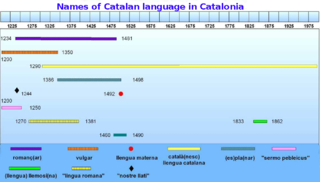
The first names, or glossonyms, of the Catalan/Valencian language formed in a dialectal relation with Latin, in which Catalan existed as a variety. These names already expressed the relationship between the two languages. New names that related Catalan to Rome came about to dignify the Catalan language in the thirteenth century, though Latinists called it vulgar and the people planus, or pla.
The Catalan Civil War, also called the Catalonian Civil War or the War against John II, was a civil war in the Principality of Catalonia, then part of the Crown of Aragon, between 1462 and 1472. The two factions, the royalists who supported John II of Aragon and the Catalan constitutionalists, disputed the extent of royal rights in Catalonia. The French entered the war at times on the side on John II and at times with the Catalans. The Catalans, who at first rallied around John's son Charles of Viana, set up several pretenders in opposition to John during the course of the conflict. Barcelona remained their stronghold to the end: with its surrender the war came to a close. John, victorious, re-established the status quo ante bellum.
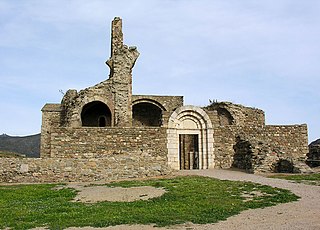
Santa Maria de Roses is a ruined Benedictine monastery in the municipality of Roses, Alt Empordà comarca, Catalonia, Spain. It is situated within the Ciutadella de Roses, a fortification in the Province of Girona. It is the earliest known example of Lombard architectural style in the country.
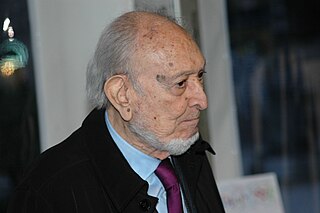
Josep Maria Castellet Díaz de Cossío, also known as José María Castellet, was a Spanish Catalan writer, poet, literacy critic, publisher and editor.

Joan Bastardas i Parera (1919–2009) was a Spanish Latinist and Romance philologist born in Barcelona. He was the son of the lawyer and politician Albert Bastardas i Sampere. He studied at the University of Barcelona, with Marià Bassols de Climent, and wrote a PhD dissertation on Medieval Latin syntax, for which he received the Antonio de Nebrija Prize (1951). He was also indirectly a student of the Swedish Latinist Dag Norberg.

Valentí Serra i Fornell, is a Spanish Capuchin and priest, whose religious name is Valentí Serra de Manresa.

The Sarrià Capuchins are a community of the Capuchins that settled in Barcelona in 1578 after a request of the Consell de Cent, and against the will of the king Philip II.
Caterina d'Ortafà, was a Catalan noblewoman. She is known for her defense of Canet-en-Roussillon during the French invasion of Roussilon following the Catalan Civil War in 1474.
Francesc de Verntallat was a Catalan nobleman who captained the Remensa Army in the War of the Remences, a conflict overshadowed by the Catalan Civil War. For this reason, de Verntallat was recompensed by King John II of Aragon, who named de Verntallat viscount of Hostoles. De Verntallat was a member of the Catalan lower noble class.

The Catalan Republic was a state proclaimed in 1931 by Francesc Macià as the "Catalan Republic within the Iberian Federation", in the context of the proclamation of the Second Spanish Republic. It was proclaimed on 14 April 1931, and superseded three days later, on 17 April, by the Generalitat de Catalunya, the Catalan institution of self-government within the Spanish Republic.

Bernat Solé i Barril is a Spanish industrial engineer and politician from Catalonia, member of the Parliament of Catalonia and Minister of Foreign Action, Institutional Relations and Transparency of Catalonia between 2020 and 2021. He was previously mayor of Agramunt. He is currently awaiting trial on charges of disobedience for his role in the Catalan declaration of independence.
Joan Ramon Folc IV de Cardona or Juan Ramón Folch IV de Cardona,, was a Catalan nobleman.
He was the 5th Count of Cardona (1486-1491) and then the 1st Duke of Cardona (1491-1513), the 6th Count of Prades, the 6th Baron of Entença (1486-1513), Viscount of Villamur (1486-1513) and the 1st Marquis of Pallars Sobirá (1491-1513).
Magí Sivillà Magoles, also written Magí Sevilla was a Catalan historian, doctor in theology, and chronicler.

Lola Badia Pàmies is a Spanish philologist, medievalist, and academic of the Reial Acadèmia de Bones Lletres de Barcelona. With her retirement in 2021, she became professor emeritus of Catalan literature at the University of Barcelona.
Hugh Roger III de Pallars Sobirà was a military leader during the Catalan Civil War and the last Count of Pallars Sobirà from 1451 to 1487 and by marriage, Baron de Ponts from 1478 to 1487.